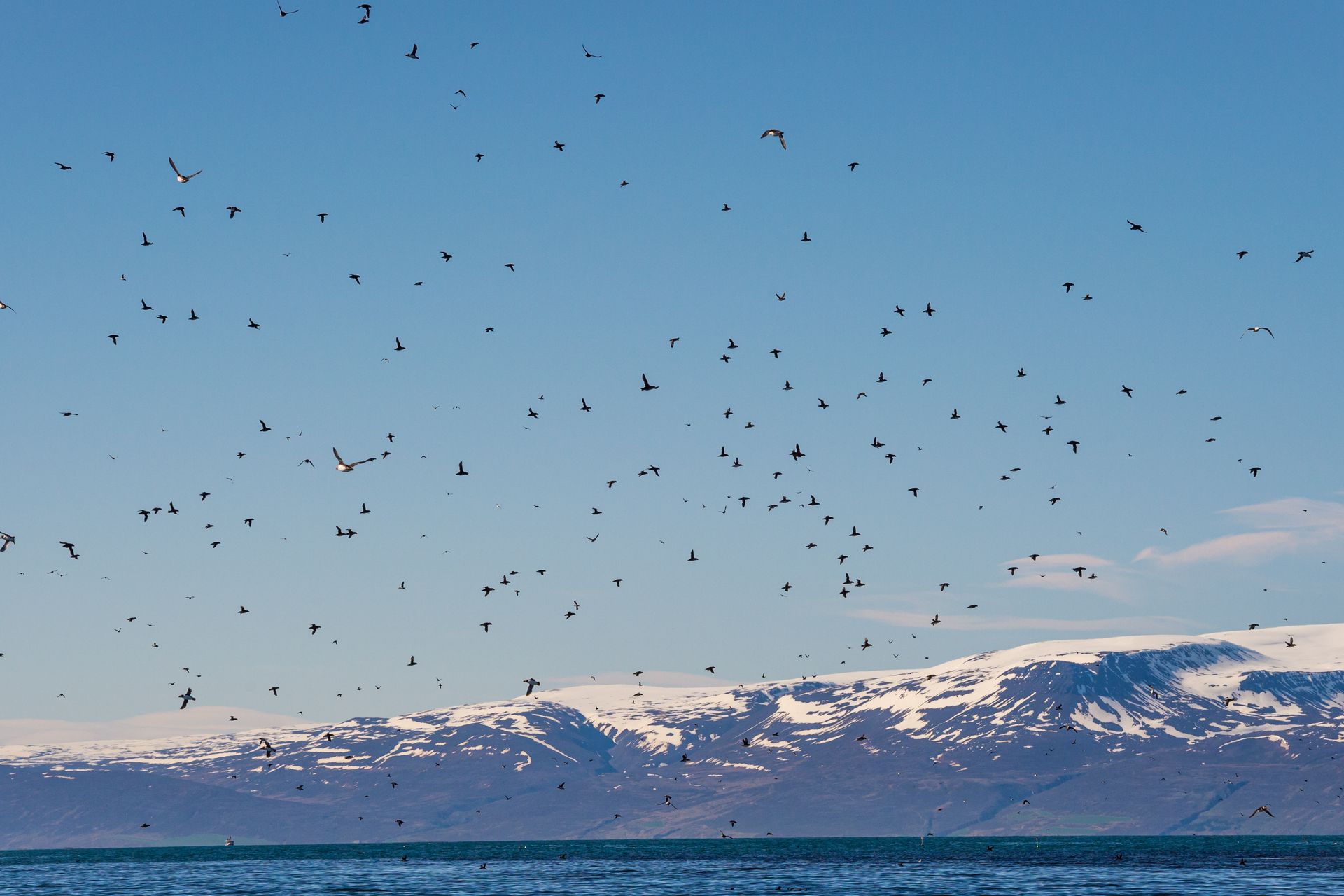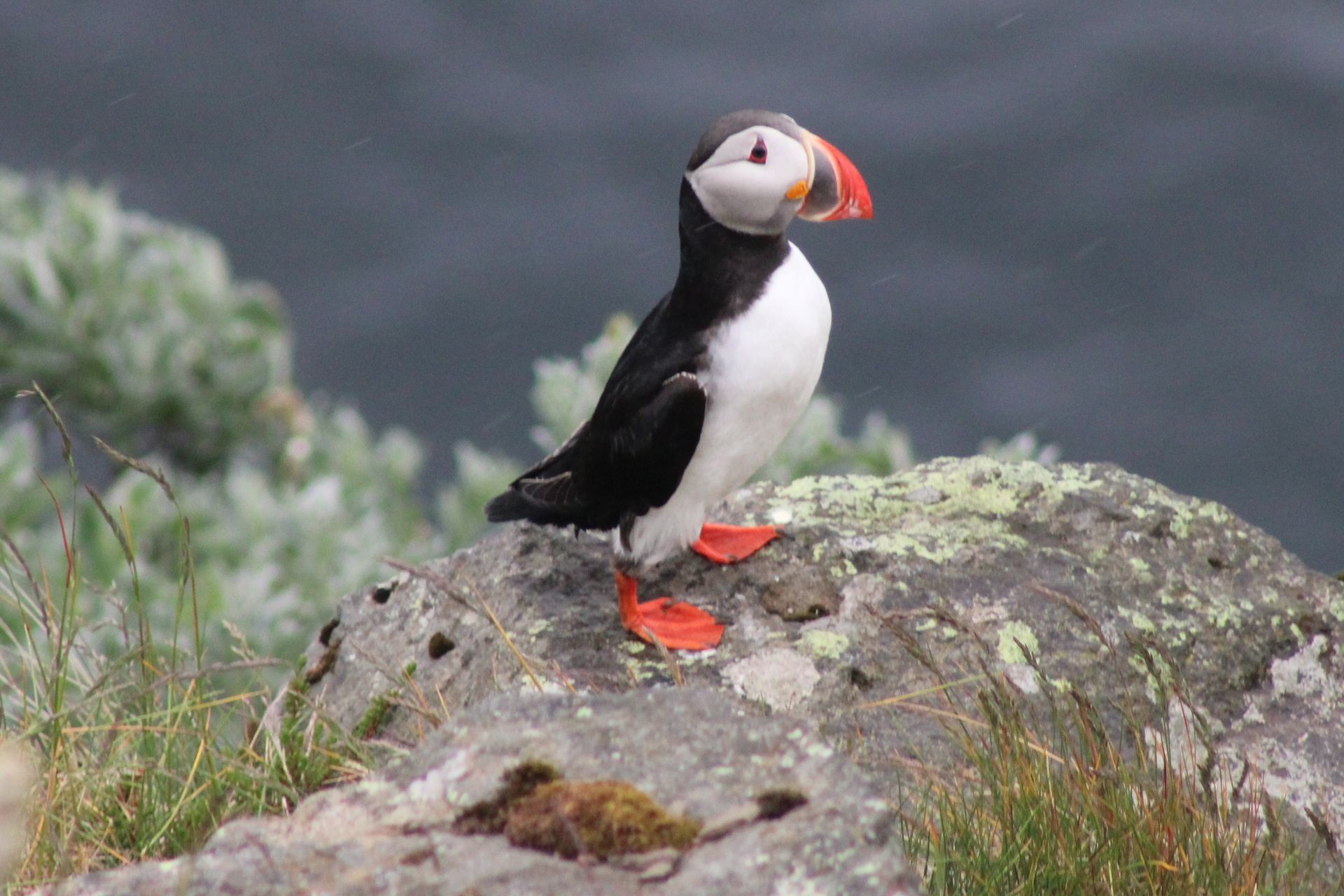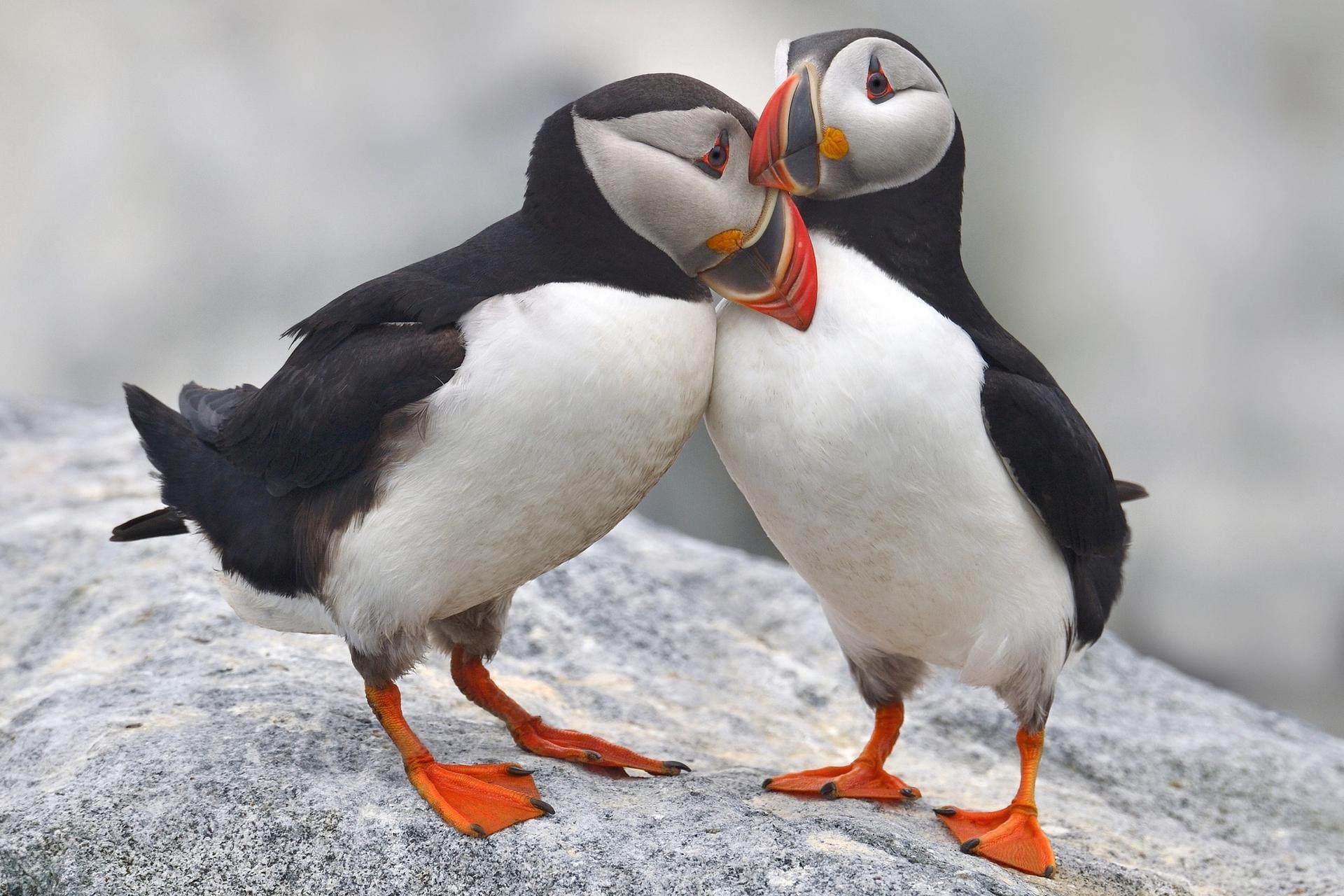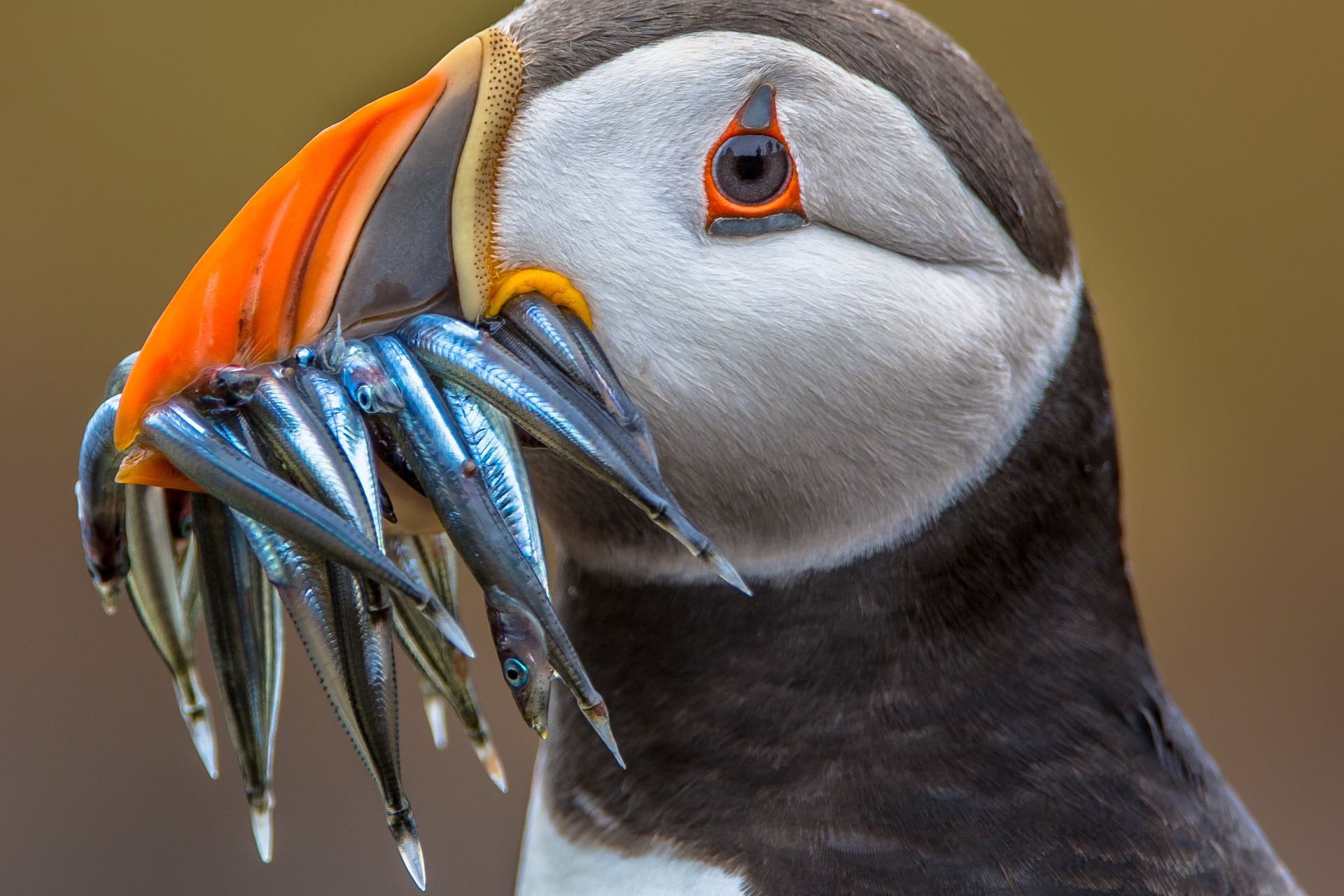 Guides
GuidesWhere to find Puffins in Iceland
Is it one of your life goals to spot a puffin? If yes, then Iceland is the place to be. These adorable birds are striking with their vibrant orange beaks and black-and-white bodies. So it is no wonder why they are so sought after by wildlife enthusiasts and bird lovers. Iceland has the largest Atlantic Puffin colony in the whole world, roughly around ten million. So we are going to recommend the top places to find these loveable birds, throughout the whole country.
When can you see puffins in Iceland?
During the summer months, you will have a greater chance of seeing puffins. They lay their nests in April and then usually stay until early September. It is known that they are more commonly spotted between May to the middle of August, as this is the main puffin season in Iceland. They lay their nests on the cliffs and then return to the ocean after breeding.
How many types of puffins?
There are four different types of puffins. They consist of Tufted Puffin, the Horned Puffin, the Atlantic Puffin, and the Rhinoceros Auklet. The Atlantic Puffin is the type you will find throughout Iceland.

Where to find Atlantic puffins?
Puffins in Iceland commonly known as Atlantic Puffins are found in the North Atlantic Ocean. You can expect them to build nests from Newfoundland to the North Eastern United States. If you are visiting Europe, Ireland, Greenland, Northern Russia, Brittany Coast, and of course Iceland are common homes for these birds.
How did puffins get their name?
Their name came from their appearance of “puffiness”. The word puffin is thought to be derived from the word 'puff' which refers to swollen. We think the history behind their name makes them even cuter.

What do puffins eat?
They eat both small fish and zooplankton. Common fish you can spot them snacking on are sand eels, capelin, sand lance, herring, and hake.
Are Puffins Dangerous?
No, they are not considered dangerous. However, they are still wild birds and will react if they feel threatened. They have bit people before but it is a rare occurrence. Most of them will come very close to humans and you may even find one sitting next to you at some point.

Do Puffins Mate For Life?
Yes, they do! Puffins are monogamous and a couple can stay together for over 20 years. They raise their babies throughout summer and then return annually to the same burrow with the same mate. How cute is that?
Where to find Puffins in Iceland
Now let’s talk about the top places in Iceland where you can spot these precious birds.

Látrabjarg cliffs.
Located in the Westfjords of Iceland is the Látrabjarg bird cliff. Látrabjarg is known to be one of the westernmost points in Europe. It is also the most extensive seabird cliff in all of Iceland. The cliffs are 1443 feet high and 44 feet long, making it quite the spectacular place
The cliffs are a bird lover’s paradise, attracting more than a million birds. Among them is the puffin. Other birds that gather here are the razorbill, guillemots, kittiwakes, and fulmar. The area is so popular because of how close the puffins get to people. They are not afraid of humans and are known to even like us. This means you can get that bucket list up close and the personal photograph you always wanted. Do not get too close though and respect their boundaries, since they are technically still wild birds.
If a puffin comes up to you, be sure not to touch them. To protect their feathers, they have oil glands at the root of their tail. If you touch them they could lose this oil which would mean their feathers could fall out.
Westman Islands
Vestmannaeyjar, also known as the Westman Islands, is a hot spot for Puffins! It is the most well-known and famous spot in Iceland to spot these cute puffy birds. Mainly because the Westman Islands are made up of fifteen different islands, attracting the birds right from the sea. The islands are exquisite and were all created from volcanic eruptions that took place below the sea. The largest of the islands in Iceland is Heimaey and is the only inhabited island of the bunch. Six of the other islands do have remote hunting cabins, but that is it.
So why these islands? Well, they are considered to be the biggest puffin breeding colony in the world. This means your chances of spotting a puffin during peak season are more than great. You can catch a glimpse of them by just walking around. They can also be seen along the cliffs, cliff tops, and by boat.
Breiðafjörður Bay
Next up is the Breiðafjörður nature reserve and bay between the Snæfellsnes Peninsula and the Westfjords in West Iceland. The location is exactly why the area attracts so many puffins. Luckily you can explore the bay firsthand with Guide Of Iceland’s boat tour on one of their well-equipped sightseeing boats. Which are Icelandic fishing boats, perfect for bird watching since the boats are smaller.
Their Puffin tour starts in Stykkishólmur where you will sail to the island of Elliðaey, which is s the main settlement for puffins on the bay. The island is packed with puffins, and during high puffin season around the middle of July, there are about 2000 couples nesting on the island.
Elliðaey is a lovely island that was inhabited until the year 1950. Marvel at the buildings, which include a house, barn, and lighthouse. The trip is perfect for photographers and those who want to snag a picture of the puffins. Luckily the boat can get extremely close to the cliffs of the island without disturbing them. You may even spot dolphins, eagles, and seals on your trip back too.
Tjörnes Peninsula
Located on the 196-foot cliffs of the Tjörnes peninsula in Northern Iceland is a big settlement of puffins. You can view them by taking a quick fifteen-minute hike to the outermost tip of Tjörnes called Voladalstorfa. These cliffs are famous in general for their remarkable features. They are multi-colored and layered and the surrounding area is rich in two-million-year-old fossils.
You can then head over to the east side of the peninsula where another puffin colony lives. This is near Hringsbjarg and there is an observation platform where you can hang out and view the puffins. The Tjörnes Peninsula is a 5-hour and 45-minute drive from Reyjavik but it is truly so worth it.
Dyrhólaey
Dyrhólaey, formerly known by sailors as Cape Portland, is a small peninsula located on the south coast of Iceland. Relatively close to the village of Vik. It was once an island of volcanic origin, which is also known by the Icelandic word “eyja” meaning island. It is about a 2-hour and 30-minute drive south of Reykjavik.
This area is fantastic for seeing puffins due to the rock arch and its surrounding stony areas. The birds enjoy relaxing and even nesting on these rocks, providing you with fantastic viewing options. You are also a short drive away from the famous black sand beach of Reynisfjara Beach.
Ingólfshöfði
Explore the isolated area of Cape Ingolfshofdi. It is a headland on the coast of Iceland, about halfway between Skaftafell in Vatnajökull National Park and Jokulsarlon Glacier Lagoon. This area is a nature reserve home to thousands of different birds. This includes the puffin of course and great skuas.
To see the puffin first hand you can take the Ingólfshöfði Puffin Tour. To get to Ingólfshöfði, the tour will bring you through waters, marshes, and sands in a tractor-drawn hay cart. Your guide will tell stories and explain the birdlife to you while leading you safely through the nesting grounds on the cape. The drive takes about 30 minutes each way. You will then spend around an hour and a half hiking around the cape.
The hike is relatively challenging taking on a steep sand slope and rocky terrain. But after the first part, it gets easier. The total distance is about 1.8 miles. The hike will allow you to see the puffins along your journey, so we think the extra effort is completely worth it!
Lundey Island
Get ready to visit “Puffin Island” also known as Lundey Island. This is a great option for those staying in Reyajvik who wants to stay close to the city. Lundey Island can be accessed via a quick boat right from the harbor.
The boat ride to Lundy usually takes less than two hours. The ship's departure time will be posted on The Marisco Tavern noticeboard at least 24 hours before the sailing. Some sailings return you to a different port from that which you departed so please speak with Ferry Services before taking your trip. You can only take the ferry during the summer months, from the end of March until the end of October.
The island is uninhabited, except for a few workers, and it is rumored to be run by the Puffins, hence the name. It is a fun day trip to do when you are staying in Reykjavik and we highly recommend adding it to your Iceland itinerary.
Iceland’s Unusual Puffin Dish
Yes, it is true, you can sometimes find Puffin on the menu in Iceland. It is a bizarre Traditional Icelandic dish and has become one of the most controversial meals in Iceland.
There is a history behind eating puffing that goes back to the settlement days. The birds needed to be hunted due to a lack of food supply in the country. But don’t worry, today the birds are protected in many countries, Iceland not being one of them. However, it is illegal to hunt the birds in a majority of the country, this does not include the northern part. The hunting ban is in South, West, and East Iceland.
Most Icelanders do not eat puffin. Besides the fight to protect the birds, they are known to be too gamey and tough to eat. If you do find it on a restaurant menu, it is normally smoked for taste. Making it similar to pastrami or it can be broiled, resembling liver. It was mainly just eaten to survive in the olden days.
The Future Of Puffins
While Puffins are not yet endangered they are in the process of it, unfortunately. The main threat they are facing is the distribution and numbers of smaller fish. This can be caused by smaller animals eating fish, it is also driven by the pollution in the water.
A sad example is the oil leak that happened in 1967 from the Torrey Canyon. The leak killed 85% of French Puffins. Due to situations like this puffins have become extinct in certain areas over time. Luckily, Iceland is still providing a great home to the birds and we are hoping they continue to nest here for the foreseeable future.

FAQ:
Can you hold a puffin in Iceland?
No, you cannot. The stress this causes the puffin will remove the natural oils that protect the feathers.
What eats a puffin?
The most significant natural predator of the puffin is the Great Black-backed Gull. This gull can catch adult puffins in mid-air.
Are puffins friendly to humans?
Yes, they are. Puffins do not often show any fear towards humans and approaching them closely is relatively easy.
Latest Blog Posts
 Guides
GuidesThe 2022 Eruption of Fagradalsfjall Volcano - An Unforgettable Iceland Volcano Eruption
Iceland has become a top destination for mind-blowing mountain hikes, volcanic hot springs, and icy glaciers. Adventurers flock to the land of fire and ice to experience these thrilling opportunities! So it is no wonder why Iceland's volcanic eruptions attract visitors from all over the world!
 Waterfalls
WaterfallsGuide to Svartifoss Waterfall in Iceland
Svartifoss, or the 'Black Waterfall', is an exquisite natural wonder tucked away in the Vatnajökull National Park of Iceland. Known for its distinctive basalt columns and cascading water, this waterfall is a must-see for nature lovers and travelers.
 Itineraries
ItinerariesTop 11 Must-Visit Volcanic Sites in Iceland
Iceland has over 130 volcanoes located throughout the country, with 30 of them still active today. Some of them are famous for recent volcanic eruptions, while others have not erupted in thousands of years. There are so many notable Iceland volcanoes, it is hard to know which ones you can visit. With the nickname of The Land of Fire and Ice, you know you won’t be disappointed when it comes to Iceland's volcanic sites. Here are our top 11 must-visit volcanic sites in Iceland!